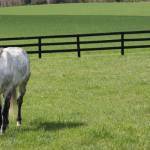Grazing Overweight Horses: Restricted Access Appropriate at Times

Are you toying with the idea of regaining control of your horse’s body condition by implementing a weight-loss plan? Depending on your horse’s situation, restricting access to pasture might be the place to start.
Why limit pasture access? Aren’t horses natural-born grazers?
While horses evolved as grazers, the quality of the pasture grasses has increased dramatically in recent years, making it unsuitable for some horses, especially those that tend to be easy keepers.
“Many horses can graze pasture grasses with no problem whatsoever. Chronically overweight and obese horses sometimes benefit from limited grazing, however, which results in caloric restriction and improved health,” explained Kathleen Crandell, Ph.D., a nutritionist for Kentucky Equine Research. “Overweight horses are at a higher risk for insulin dysregulation and metabolic syndrome, both of which can lead to laminitis.”
In addition, many horse owners use restricted grazing preemptively to keep horses and ponies from becoming overweight.
What’s the best approach to restrict pasture intake?
Horse owners have found several ways to successfully restrict pasture intake. The method used is often dependent on access to facilities and turnout areas, owner schedule, and what works best for the individual horse, according to Crandell. A trial-and-error approach must often be taken. Effective methods include:
- Strip grazing, which uses temporary fencing to section off areas of a larger field, allowing horses to graze fresh pasture in a controlled, strategic manner and moving the fences as pasture is eaten down.
- Feed limited hay (weighed at about 1.5-2% of body weight) provided in a way that slows consumption (e.g., small-hole haynets). For horses at risk for laminitis, hay should be tested for nonstructural carbohydrate content (below 12% is recommended).
- Use of drylots that allow limited or no access to pasture, but appropriate hay or other preserved forage is allocated, the quality of which is dictated by age, workload, and metabolic status of horses.
- Well-fitted grazing muzzles curb consumption by allowing horses to eat through holes or slits.
With all these options available, how do I know which method is the best?
Results of a recent survey in England may help you decide.* Nearly 470 respondents had experience using one or more of the aforementioned restricted grazing methods. The most important considerations reported by respondents were practicality and welfare.
Fencing for strip grazing is more expensive and labor intensive than grazing muzzles, and these costs may therefore limit the method employed. Further, most boarding facilities have management restrictions. Owners are typically not allowed to alter a paddock, have only limited opportunities for turning out their horse (especially during inclement weather), and do not have the space or resources for drylots.
In terms of welfare, grazing muzzles had a low “welfare rating” by owners participating in the study, yet muzzles were frequently used. The researchers suggested that this disparity likely arose because muzzles are inexpensive and not particularly labor intensive.
While grazing muzzles got a bad rap in terms of welfare, respondents may not have fully understood the benefits of muzzling. For example, horses evolved as trickle feeders, grazing almost continuously for 16-18 hours a day. When their grazing time is restricted, horses are at risk of gastric ulceration, alterations in the equine intestinal microbiome, and behavioral changes, such as the development of stereotypies.
According to Crandell, “Muzzles do not necessarily limit a horse’s time spent grazing or exercising; they do, however, restrict the amount of grass that can be consumed. Muzzles also allow horses to have contact with their peers, which means this approach supports both the physical and psychological needs of the horse.”
Horses fed all-forage diets benefit from a ration balancer or a high-quality vitamin and mineral supplement, as these products provide important nutrients that are often in short supply in fresh and preserved forages.
Crandell also recommends addressing the potential stress associated with restricted grazing. “Horses with restricted grazing may benefit from a research-proven digestive supplement, such as Triacton.” Triacton provides total digestive tract support, including ingredients that buffer both the stomach and hindgut for gastrointestinal protection during times of stress.
*Cameron, A., P. Harris, A. Longland, S. Horseman, and J. Hockenhull. 2021. UK horse carers’ experiences of restricting grazing when aiming to prevent health issues in their horses. Journal of Equine Veterinary Science 104:103685.








